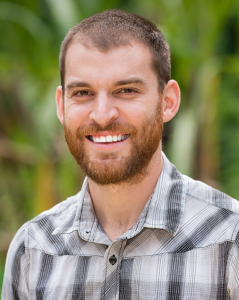By: Anthony Florig, BSBA
Purchasing and Farm Manager
Almost all of the gardens at Pacific Quest are built from the ground up, and also down, by the hands and hearts of all the students and staff that find their way to the Big Island of Hawaii. I would like to share a story about the construction of these gardens, and the parallel process of the development of our students.
The garden camps have been a work in progress for over ten years, constantly changing and evolving and growing along with our student population. When I was a Guide for the Young Adult Program at Reed’s Bay, our Kuleana (Hawaiian for “personal responsibility”) student group was responsible for clearing an area that has come to be known as The Village, the property adjacent to the main Young Adult building in Hilo. It is a small outcropping overlooking Reed’s Bay, surrounded by rock-walled spring-fed brackish pools known as The Ice Ponds. These ponds connect to Reed’s Bay via a small channel, so you can enter for a refreshingly cold dip and then swim out to the bay where the ocean water is warmer.
The entire Village area used to be covered in cane grass, and was being overtaken by the coastal jungle. Now it is a beautifully landscaped garden park full of Hawaiian canoe plants like taro (kalo), purple sweet potato (uala), turmeric (olena), and banana (maia). To enter The Village you need to cross a small red wooden bridge that spans the first two ice ponds. You are met with various types and colors of Ti trees, with flowers and herbs planted in tree-trunk planters lining the path, leading to a dug-in stone fire circle. There are large garden beds with taro and purple sweet potatoes on either side of the clearing. Off the main path there is a rock-lined meditation labyrinth next to another ice pond. From the fire circle you can follow another path through more Ti trees and colorful relative Cordylines, with white pineapples growing along their base. From here you can continue on to the compost pile (or ki’pulu as we call it here in Hawaii) past various young fruit trees including mango, avocado, soursop, breadfruit (ulu), and plenty of ice cream and apple bananas. Or you can turn right and head past the Red Cuban bananas towards the final ice pond, which is surrounded by a canopy of thick Hau trees (ocean hibiscus). Over the course of the day the vibrant yellow flowers will turn orange and eventually fall into the pond, creating an idyllic scene and popular favorite spot for reflection.
About three years ago, there was one area underneath a large banyan tree that used to be nothing but vines. I remember a particularly rambunctious group of students who needed to get out some serious energy, both physically and mentally. They wanted a punching bag, so I agreed to make one with them. I got an old tarp and we began pulling all the vines off the hillside. For each bunch of vines we placed on the tarp we spoke about something that was bothering us, or that we were angry at. As students identified people or situations they were mad at, we helped identify the feelings and root causes of their pain. One student in particular who had been slow to open up really led this project, and she was able to speak about many of her resentments and what she called her enemies, and also how she wants to learn to forgive them and to let them go. We packed all the vines in the tarp, rolled it up, and tied it into a pretty solid punching bag. The students really enjoyed themselves getting out some more energy and aggression, but pulling the vines seemed to have already worked as a regulatory activity. In fact, underneath the vines we discovered a small hillside of some very rich soil, which was quite a pleasant surprise and grabbed everyone’s attention.
Today that hillside is now two terraced garden beds that wrap around the banyan tree and produce pounds and pounds of turmeric, taro and purple sweet potato. These beds were created and farmed the same way the vines were cleared from the hillside, by a group of staff and students talking about their problems and working them out on the land, over and over again. On top of the hill is a cleared circle of black cinder surrounded by a small rock wall, inside is a ring of coconut log seats. This is now a popular location for council and ceremony, or just a shady place to talk story surrounded by years of intention mixed with the beauty of Hawaiian tropical agriculture.
